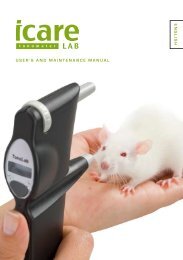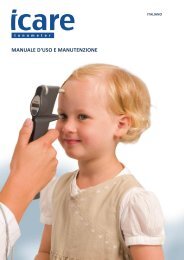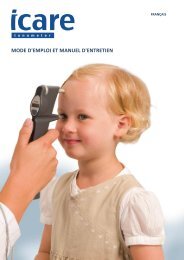USER'S AND MAINTENANCE MANUAL - Icare Finland
USER'S AND MAINTENANCE MANUAL - Icare Finland
USER'S AND MAINTENANCE MANUAL - Icare Finland
Create successful ePaper yourself
Turn your PDF publications into a flip-book with our unique Google optimized e-Paper software.
ENGLISH<br />
U S ER ’ S AN D M AI N TEN AN CE M AN U AL<br />
www.icaretonometer.com 1
<strong>Icare</strong> tonometer TA01i manual<br />
English<br />
TONOMETER<br />
<strong>Icare</strong>® TA01i<br />
INSTRUCTION <strong>MANUAL</strong> v2.2 04/12<br />
EN<br />
This device complies with:<br />
Medical Device Directive 93/42/EEC<br />
Canadian Medical Device Regulations<br />
Copyright © 2009 <strong>Icare</strong> <strong>Finland</strong> Oy<br />
Made in <strong>Finland</strong><br />
<strong>Icare</strong> <strong>Finland</strong> Oy<br />
Hevosenkenkä 3, FI-02600 Espoo, <strong>Finland</strong><br />
Tel. +358 9 8775 1150, Fax +358 9 728 6670<br />
www.icarefinland.com, info@icarefinland.com<br />
Indications for use ...................................................................................................................................................................................................................... 2<br />
Introduction ............................................................................................................................................................................................................................... 2<br />
Safety instructions ...................................................................................................................................................................................................................... 3<br />
Parts of the tonometer ............................................................................................................................................................................................................... 3<br />
Turning the tonometer on and loading the probe ...................................................................................................................................................................... 4<br />
Measurement ............................................................................................................................................................................................................................. 4<br />
Display after measurements ...................................................................................................................................................................................................... 5<br />
Other functions .......................................................................................................................................................................................................................... 5<br />
Accessing old measurement value ............................................................................................................................................................................................. 5<br />
Turning the tonometer off ......................................................................................................................................................................................................... 5<br />
Replacing the probe base ........................................................................................................................................................................................................... 5<br />
Replacing the batteries .............................................................................................................................................................................................................. 6<br />
Error messages ........................................................................................................................................................................................................................... 6<br />
Service procedures ..................................................................................................................................................................................................................... 6<br />
Technical information ................................................................................................................................................................................................................ 7<br />
Spare parts and supplies ............................................................................................................................................................................................................ 7<br />
Performance data....................................................................................................................................................................................................................... 7<br />
Diagram of tonometer functions ................................................................................................................................................................................................ 7<br />
Maintenance .............................................................................................................................................................................................................................. 8<br />
INDICATIONS FOR USE<br />
The <strong>Icare</strong> tonometer TA01i is intended to be used for the measurement of intraocular pressure in the human eye.<br />
INTRODUCTION<br />
The <strong>Icare</strong> tonometer is used in the diagnosis, follow up and screening of glaucoma. It is based on a new, patented, induction-based rebound method,<br />
which allows intraocular pressure (IOP) to be measured accurately, rapidly and without an anesthetic.<br />
Since single-use probes are used for measurement, there is no risk of microbiological contamination. Intraocular pressure changes due to the effects of<br />
the pulse, breathing, eye movements and body position. Because measurements are taken using a handheld device in fractions of a second, several<br />
measurements are needed to obtain an accurate reading and there fore the software is pre-programmed for six measurements.<br />
www.icaretonometer.com 2
<strong>Icare</strong> tonometer TA01i manual<br />
English<br />
SAFETY INSTRUCTIONS<br />
WARNING<br />
The tonometer must not come into contact with the patient’s eyes, except for the probes, which may do so for a fraction of a second during<br />
measurement. Do not bring the tonometer into contact with the eye or push it into the eye (the tip of the probe should be 4-8mm, or 1/6 – 1/3 inch,<br />
from the eye).<br />
CAUTION<br />
Read this manual carefully, since it contains important information on using and servicing the tonometer.<br />
Retain this manual for future use.<br />
When you have opened the package, check for any external damage or faults, particularly for damage to the case. If you suspect that there is something<br />
wrong with the tonometer, contact the manufacturer or distributor.<br />
Use the tonometer only for measuring intraocular pressure. Any other use is improper and the manufacturer cannot be held liable for any damage arising<br />
from improper use, or for the consequences thereof.<br />
Never open the casing of the tonometer, except for the battery compartment or to change the probe base.<br />
This manual contains instructions for replacing batteries and changing the probe base.<br />
Never use the tonometer in wet or damp conditions.<br />
The probe base, battery compartment cover, screws, collar and probes are so small that a child could swallow them. Keep the tonometer out of the reach<br />
of children.<br />
Do not use the device near inflammable substances, including inflammable anesthetic agents.<br />
Prior to each measurement, check that a new disposable probe from an intact package is being used.<br />
Be sure that the probe contains the small plastic round tip in front.<br />
Certain microbiological agents (e.g. bacteria) can be transmitted from the forehead support.<br />
To avoid this, the forehead support should be cleaned regularly with a disinfectant, e.g. an alcohol solution.<br />
The tonometer conforms to EMC requirements (IEC 60101-1-2: 2001), but interference may occur in it if used near (
<strong>Icare</strong> tonometer TA01i manual<br />
English<br />
TURNING THE TONOMETER ON <strong>AND</strong> LOADING THE PROBE<br />
Place the wrist strap into the wrist strap attachment. Place the wrist strap around your wrist and secure it. The<br />
wrist strap protects the tonometer from dropping onto the floor accidentally. Insert batteries into the tonometer<br />
(page 9).<br />
Press the measurement button to turn the tonometer ON. The tonometer display will display all of the LCD<br />
segments (see the figure beside). Check that all of the segments are functional in the four-digit, sevensegment<br />
LCD display.<br />
Following a brief pause, the display will show “LoAd,” reminding the user to load the single use probe into the tonometer prior to measurement.<br />
Load the probe in the following way:<br />
Open the probe tube by removing<br />
the cap and insert the probe into<br />
probe base as shown in the<br />
image. After the probe has been<br />
inserted, be careful not to point it<br />
down before activating the<br />
tonometer in order to prevent<br />
the probe from falling out.<br />
Activate by pressing the<br />
easurement button once and the<br />
tonometer will be ready for<br />
measurement when 00 appears<br />
on the display. After activating<br />
the probe is magnetized and will<br />
not fall out.<br />
To obtain firm<br />
support for the<br />
patient’s<br />
forehead, in order<br />
to obtain an<br />
accurate<br />
measurement at<br />
the right distance,<br />
you can adjust the<br />
forehead support<br />
by turning the<br />
forehead support<br />
adjusting wheel.<br />
MEASUREMENT<br />
*Since local anesthetic may lower the tonometer reading, we recommend<br />
that you refrain from using an anesthetic when performing measurements.<br />
Ask the patient to relax and look straight ahead at a specific point. Bring the<br />
tonometer near the patient’s eye. The central groove should be in a horizontal<br />
position, and the distance from the eye to the front part of the collar should<br />
be the length of the collar. In other words, the distance from the tip of the<br />
probe to the patient’s cornea (see picture) should be 4-8 mm (1/6-1/3 inch).<br />
If necessary, adjust the distance by turning the forehead support adjusting wheel. Press the measurement button lightly to perform the measurement,<br />
taking care not to shake the tonometer. The tip of the probe should make contact with the central cornea. Six measurements are made consecutively.<br />
After each successful measurement, you will hear a short beep. Once the six measurements have been performed, the IOP will be shown on the display<br />
after the ‘P’.<br />
If there is an erroneous measurement, the tonometer will beep twice and display an error message. Press the measurement button to clear the error<br />
message. If several erroneous measurements appear, see error messages (page 10).<br />
To obtain the most accurate reading, six measurements are required, but the result is also displayed after the first measurement, which can usually be<br />
considered valid. The measurement values displayed are average values for all previous measurements (1.-5.). Single measurement values are not shown.<br />
Should there be variation between the measurements, ‘P’ will flash on the display after the sixth measurement.<br />
Following the performance of the entire measurement, a new measurement series can be begun by pressing the measurement button. The tonometer<br />
will then be ready for the next measurement series (00 will show on the display, see page 8).<br />
If the user doubts the validity of the measurement (for example, if the probe made contact with the eyelid, or missed the central cornea etc.), we<br />
recommend that he/she make a new measurement. In addition, when encountering unusual values (for example over 22mmHg or below 8 mmHg)<br />
we recommend the performance of a new measurement to verify the result.<br />
*Badouin C, Gastaud P. Influence of topical anesthesia on tonometeric values of intraocular pressure. Ophthalmologica 1994;208:309-313<br />
www.icaretonometer.com<br />
4
<strong>Icare</strong> tonometer TA01i manual<br />
English<br />
DISPLAY AFTER MEASUREMENTS<br />
Before After the second measurement After the sixth measurement<br />
00 2.13 P 13<br />
After the sixth measurement, the letter P appears on the display, followed by the IOP (Intraocular pressure) reading.<br />
If the P is blinking, it means that the standard deviation of the measurements is greater than normal.<br />
P _ (line down) The standard deviation of the different measurements has a slightly greater value than normally, but the effect on the result is unlikely to<br />
be relevant.<br />
P-(line in the middle) The standard deviation of the different measurements is clearly greater than normal, but the effect on the result is probably<br />
irrelevant. A new measurement is recommended if the IOP is over 19 mmHg.<br />
P – (line up) The standard deviation of the different measurements is great and a new measurement is recommended.<br />
OTHER FUNCTIONS<br />
Accessing old measurement value<br />
From the starting position, press the right or left selector button<br />
until ‘Old’ appears on the display. Then press the measurement<br />
button. You can now ‘scroll’ through the old values by pressing<br />
the selector buttons (right=older, left=more recent, from 0-9).<br />
To exit the old values search, press the measurement button.<br />
The display will now show the word ‘Old’. Press either selector button to access other functions (00=measurement, End=turning OFF).<br />
Turning the tonometer OFF<br />
Press either selector button until the display shows ‘End‘. Press<br />
the measurement button for two seconds - the display will show<br />
‘byE’ and the tonometer will switch off. The used probe will be<br />
partially ejected. Use the used package to remove it from the<br />
tonometer. Ensure that you dispose of the probe properly.<br />
Replacing the probe base<br />
After several months of use, dust may collect in the probe base, affecting the probe movement. The probe base should be replaced if the probe no longer<br />
moves smoothly.<br />
Unscrew the probe base collar and put it in a safe place.<br />
Remove the probe base by tilting the tonometer downwards and pull the probe base out of<br />
the tonometer.<br />
Insert a new probe base into the tonometer.<br />
Screw the collar in, to lock the probe base.<br />
www.icaretonometer.com<br />
5
<strong>Icare</strong> tonometer TA01i manual<br />
English<br />
Replacing the batteries<br />
Unscrew the battery compartment locking screw with a screwdriver or a small coin.<br />
Remove the battery compartment cover. Remove the old batteries.<br />
Insert a new set of batteries (four AA batteries). Do not use rechargeable batteries, since they may not function properly (the inner resistance of some<br />
rechargeable batteries is too high). Insert the batteries in accordance with the diagrams inside the battery compartment, with the +terminals pointing<br />
downwards on the display side of the tonometer (the rear side), and the -terminals pointing downwards on the measurement side (the front side).<br />
Replace the battery compartment cover and secure it by screwing it in lightly using the coin or screwdriver. Take care not to use excessive force when<br />
screwing the cover into place.<br />
Battery compartment cover<br />
Error messages<br />
To clear error messages, press the measurement button, after which the measurement can be repeated. The following messages may appear:<br />
MESSAGE STATE DESCRIPTION<br />
bAtt The batteries are low. Replace the batteries.<br />
E 01 The probe did not move at all. If this error message is repeated, turn the tonometer so that the<br />
collar faces down for a short time. If the error message is<br />
repeated, remove the probe base and replace it with new ones<br />
(see page 9).<br />
E 02 The probe did not touch the eye. The measurement was taken from too far away.<br />
E 03 The probe speed was too low. The measurement was taken from too far away or the<br />
tonometer was tilted too far upwards.<br />
E 04 The probe speed was too high. The tonometer was probably tilted downwards. Make sure that<br />
the central groove is in the horizontal position.<br />
E 05 The contact with the eye was too “soft.” The probe probably made contact with the eyelid.<br />
E 06 The contact with the eye was too “hard.” The probe made contact with the opening eyelid or calcification<br />
in the cornea.<br />
E 07<br />
The probe measurement signal detected by the<br />
tonometer was unusual.<br />
The probe may have made contact with a peripheral part of the<br />
cornea or the probe was twisted or otherwise inserted<br />
incorrectly. If this error message repeats, remove and replace<br />
the probe.<br />
E 09 Bad data. An erroneous measurement for a reason other than those<br />
described in E01−E07.<br />
SERVICE PROCEDURES<br />
Replace the batteries when the message appears.<br />
Change the probe base if the probe does not move smoothly.<br />
No other service procedures can be carried out by the user. All other servicing and repairs must be carried out by the manufacturer or<br />
certified service facilities.<br />
The device can be cleaned with a damp cloth containing disinfectant.<br />
www.icaretonometer.com<br />
6
<strong>Icare</strong> tonometer TA01i manual<br />
English<br />
TECHNICAL INFORMATION<br />
Type: TA01i.<br />
The device conforms to CE regulations.<br />
Dimensions: 13 – 32 mm (W) * 45 – 80 mm (H) * 230 mm (L).<br />
Weight: 155 g (without batteries), 250 g (4 x AA batteries).<br />
Power supply: 4 x AA batteries.<br />
Measurement range: 7-50 mmHg, display range: 0-99 mmHg (IOP estimation beyond the measuring range).<br />
Accuracy (95 % tolerance interval relative to manometry): ±1.2 mmHg (≤20 mmHg) and ±2.2 mmHg (>20 mmHg).<br />
Repeatability (coefficient of variation):
<strong>Icare</strong> tonometer TA01i manual<br />
English<br />
<strong>MAINTENANCE</strong><br />
Follow local regulations and recycling instructions regarding the disposal or recycling of the <strong>Icare</strong> tonometerand accessories.<br />
Returning the <strong>Icare</strong> tonometer for servicing /repair<br />
Contact <strong>Icare</strong> <strong>Finland</strong>’s Technical Services Department (see www.icarefinland.com) or your local <strong>Icare</strong> representative for shipping instructions. Unless<br />
otherwise instructed by <strong>Icare</strong> <strong>Finland</strong>, there is no need to ship accessories along with the tonometer. Use a suitable carton with the appropriate packaging<br />
material to protect the device during shipment.<br />
Return the device using any shipping method that includes proof of delivery.<br />
Service<br />
WARNING<br />
The tonometer should only be opened by qualified service personnel. It contains no userserviceable parts, apart from the batteries and a probe base.<br />
The <strong>Icare</strong> tonometerrequires no routine servicing or calibration other than changing the batteries at least every 12 months or changing the probe base.<br />
If servicing is necessary, contact qualified service personnel or your local <strong>Icare</strong> representative.<br />
Periodic Safety Checks<br />
We recommend that the following checks be performed every 24 months.<br />
Equipment inspection for mechanical and functional damage.<br />
Inspection of safety labels for legibility.<br />
Cleaning<br />
CAUTION<br />
Do not spray, pour or spill liquid onto the <strong>Icare</strong>® Tonometer, its accessories, connectors, switches or openings in the chassis.<br />
When surface-cleaning and disinfecting the tonometer, follow your institution’s procedures or:<br />
The <strong>Icare</strong> tonometermay be surface-cleaned using a soft cloth dampened with either a commercial, nonabrasive cleaner or a solution of 70% alcohol in<br />
water. Lightly wipe the surfaces of the tonometer.<br />
The probe base can be cleaned separately, outside the tonometer, by carefully injecting isopropyl alcohol through the probe base. Dry the<br />
probe base by injecting some air carefully into the probe base and heating the part gently, for example with a hairdryer.<br />
Patents and copyrights<br />
US Patent No 6,093,147 and patents pending. The <strong>Icare</strong> tonometer is also protected by the applicable copyright laws.<br />
Symbols<br />
Attention!!! See instructions<br />
Lot number<br />
Serial number<br />
Manufacturing date<br />
Single use only<br />
Sterilized using radiation<br />
B-type device<br />
Keep dry<br />
www.icaretonometer.com<br />
8

















